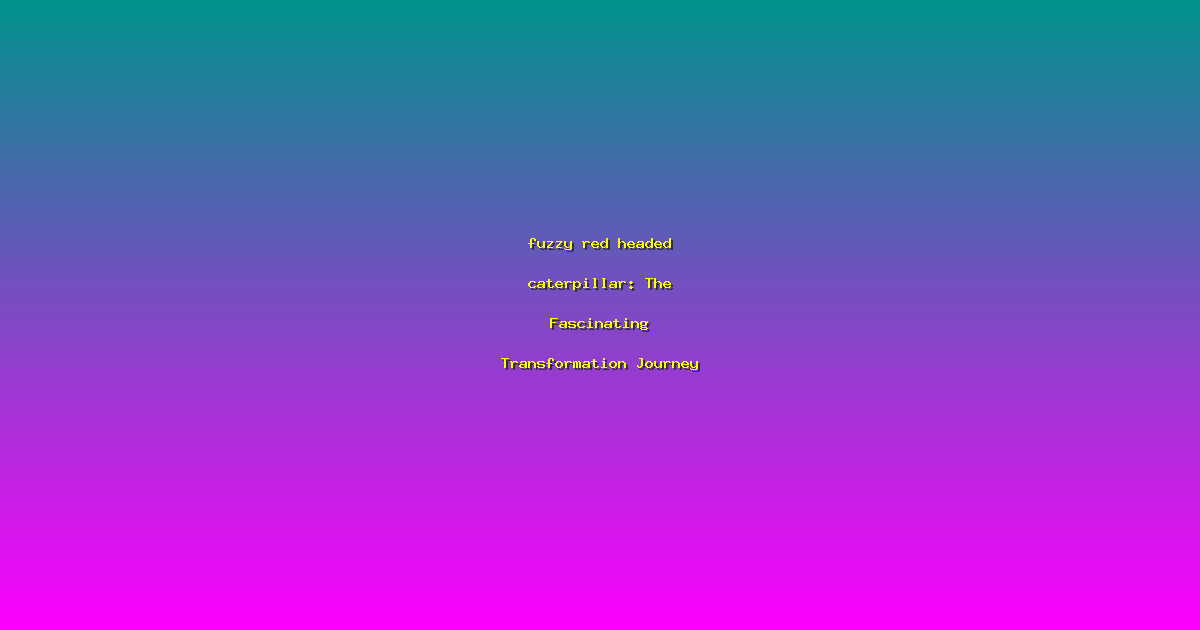fuzzy red headed caterpillar: The Fascinating Transformation Journey
Imagine a world where a fuzzy red headed caterpillar undergoes a miraculous transformation, evolving from a humble larva into a stunning butterfly. This captivating journey is not just a biological marvel but also a symbol of resilience and change. In this article, we’ll explore the life cycle of the fuzzy red headed caterpillar, uncovering the secrets behind its fascinating metamorphosis. By the end, you’ll have a deeper appreciation for these tiny creatures and their incredible journey.
The Life Cycle of the Fuzzy Red Headed Caterpillar
The fuzzy red headed caterpillar, scientifically known as Phobetron pithecium, is a remarkable creature that undergoes a series of stages in its life cycle. From egg to adult butterfly, each phase is crucial for its survival and development. Let’s dive into the details of this incredible journey.
- Egg Stage: The journey begins when a female butterfly lays her eggs on the leaves of specific host plants. These eggs are tiny and often camouflaged to protect them from predators. Within a week, the eggs hatch, and the fuzzy red headed caterpillars emerge.
- Larval Stage: Once hatched, the caterpillars begin to feed voraciously on the leaves of their host plants. During this stage, they grow rapidly, shedding their skin several times as they increase in size. The fuzzy red headed caterpillar is easily recognizable by its distinctive red head and fuzzy body, which serve as a warning to potential predators.
- Pupal Stage: After reaching a certain size, the caterpillar finds a safe spot to form a chrysalis. Inside this protective casing, the caterpillar undergoes a complete transformation, reorganizing its body to form the adult butterfly. This stage can last anywhere from a few weeks to several months, depending on environmental conditions.
Unique Features and Adaptations
The fuzzy red headed caterpillar has several unique features and adaptations that help it survive and thrive in its environment. These adaptations are crucial for its survival during each stage of its life cycle.
- Camouflage and Warning Coloration: The fuzzy red head and body of the caterpillar serve as a warning to predators. This aposematic coloration signals that the caterpillar may be toxic or unpalatable, deterring potential threats.
- Feeding Habits: The caterpillar feeds on specific host plants, such as Salix (willow) and Populus (poplar). These plants provide the necessary nutrients for the caterpillar to grow and develop.
- Chrysalis Formation: The chrysalis is not just a protective casing but also a site of intense biological activity. Inside, the caterpillar’s body undergoes a complete transformation, with tissues and organs breaking down and reforming into those of an adult butterfly.
The Impact of Environmental Factors
The fuzzy red headed caterpillar’s journey is influenced by various environmental factors, including temperature, humidity, and the availability of host plants. Understanding these factors can help us appreciate the complexity of the caterpillar’s life cycle and the challenges it faces.
- Temperature and Humidity: The temperature and humidity levels play a crucial role in the development of the caterpillar. Optimal conditions can accelerate growth and development, while extreme conditions can slow down or even halt the process.
- Host Plant Availability: The availability of host plants is essential for the caterpillar’s survival. Without the necessary food source, the caterpillar cannot grow and develop properly. Conservation efforts to protect these plants are vital for the survival of the species.
- Predation and Parasitism: Predators and parasitoids pose a significant threat to the fuzzy red headed caterpillar. However, the caterpillar’s unique adaptations, such as its warning coloration, help it avoid predation and survive to the next stage of its life cycle.
Frequently Asked Questions
How long does it take for a fuzzy red headed caterpillar to transform into a butterfly?
The transformation process from caterpillar to butterfly can take anywhere from a few weeks to several months, depending on environmental conditions. Factors such as temperature, humidity, and the availability of food sources can influence the duration of this process.
What are the main predators of the fuzzy red headed caterpillar?
The fuzzy red headed caterpillar faces threats from various predators, including birds, spiders, and other insects. However, its distinctive red head and fuzzy body serve as a warning to potential predators, deterring them from attacking.
How can I help protect the fuzzy red headed caterpillar?
Protecting the fuzzy red headed caterpillar involves preserving its natural habitat and host plants. Planting willow and poplar trees in your garden can provide a safe haven for these caterpillars. Additionally, avoiding the use of pesticides and promoting conservation efforts can help ensure the survival of this species.
Are fuzzy red headed caterpillars harmful to humans?
While the fuzzy red headed caterpillar’s appearance may be alarming, it is not harmful to humans. The red head and fuzzy body are primarily for deterring predators. However, it’s always a good idea to handle any caterpillar with care to avoid any potential irritation.
What is the significance of the fuzzy red headed caterpillar in its ecosystem?
The fuzzy red headed caterpillar plays a vital role in its ecosystem. As a herbivore, it helps control the growth of certain plant species. Additionally, it serves as a food source for other animals, contributing to the balance of the ecosystem.
Conclusion
The fuzzy red headed caterpillar’s transformation journey is a testament to the wonders of nature. From its distinctive appearance to its incredible metamorphosis, this tiny creature has much to teach us about resilience and adaptation. By understanding and protecting these fascinating creatures, we can ensure that future generations can continue to marvel at the fuzzy red headed caterpillar’s incredible journey.
